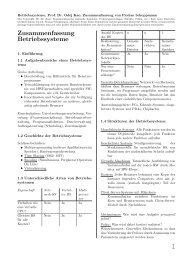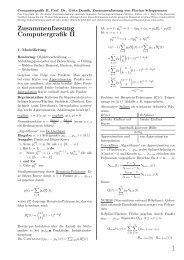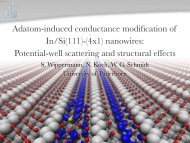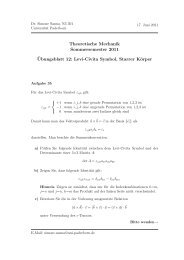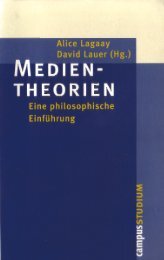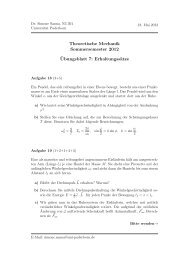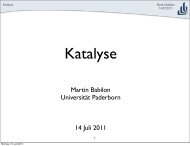Skript / lecture notes - Universität Paderborn
Skript / lecture notes - Universität Paderborn
Skript / lecture notes - Universität Paderborn
Sie wollen auch ein ePaper? Erhöhen Sie die Reichweite Ihrer Titel.
YUMPU macht aus Druck-PDFs automatisch weboptimierte ePaper, die Google liebt.
Prof. Dr. Wolf Gero Schmidt<br />
<strong>Universität</strong> <strong>Paderborn</strong>, Lehrstuhl für Theoretische Physik<br />
Bem: Um die Zustände mit negativer Energie physikalisch interpretieren zu können,<br />
nahm Dirac an, daß alle Zustände negativer Energie vollständig besetzt seien. Nach<br />
dem Pauli’schen Ausschließungsprinzip finden damit in dem sogenannten “Dirac–<br />
See” keine weiteren Teilchen Platz, und es ist ausgeschlossen, daß ein Elektron durch<br />
das Fallen in immer tiefere Zustände unendlich viel Strahlung emittiert. Anregung<br />
eines Teilchens aus dem Dirac–See erzeugt ein reales Elektron mit negativer Ladung,<br />
dem ein effektiv positiv geladenes Loch im Dirac–See gegenübersteht. Dieses<br />
Loch wird “Positron” genannt und stellt das Antiteilchen zum Elektron dar. Durch<br />
Paarvernichtung können Elektronen und Positronen annihilieren.<br />
Note: The DE is extremely successful in describing electron dynamics. However, it possesses<br />
a peculiar feature: for each quantum state possessing a positive energy E,<br />
there is a corresponding state with energy −E. This is not a big difficulty when<br />
an isolated electron is considered, because its energy is conserved and negativeenergy<br />
electrons may be left out. However, difficulties arise when effects of the<br />
electromagnetic field are considered, because a positive-energy electron would be<br />
able to shed energy by continuously emitting photons, a process that could continue<br />
without limit as the electron descends into lower and lower energy states. Real<br />
electrons clearly do not behave in this way. Dirac’s solution to this was to turn to<br />
the Pauli exclusion principle. Electrons are fermions, and obey the exclusion principle,<br />
which means that no two electrons can share a single energy state within an<br />
atom (if spin is ignored). Dirac hypothesized that what we think of as the ”vacuum”<br />
is actually the state in which all the negative-energy states are filled, and none of<br />
the positive-energy states. Therefore, if we want to introduce a single electron we<br />
would have to put it in a positive-energy state, as all the negative-energy states<br />
are occupied. Furthermore, even if the electron loses energy by emitting photons it<br />
would be forbidden from dropping below zero energy. Dirac also pointed out that<br />
a situation might exist in which all the negative-energy states are occupied except<br />
one. This ”hole” in the ”Dirac sea” of negative-energy electrons would respond to<br />
electric fields as though it were a positively-charged particle. Initially, Dirac identified<br />
this hole as a proton. However, Robert Oppenheimer pointed out that an<br />
electron and its hole would be able to annihilate each other, releasing energy on<br />
the order of the electron’s rest energy in the form of energetic photons; if holes were<br />
protons, stable atoms would not exist. Hermann Weyl also noted that a hole should<br />
act as though it has the same mass as an electron, whereas the proton is about two<br />
thousand times heavier. The issue was finally resolved in 1932 when the positron<br />
was discovered by Carl Anderson, with all the physical properties predicted for the<br />
Dirac hole.<br />
97




